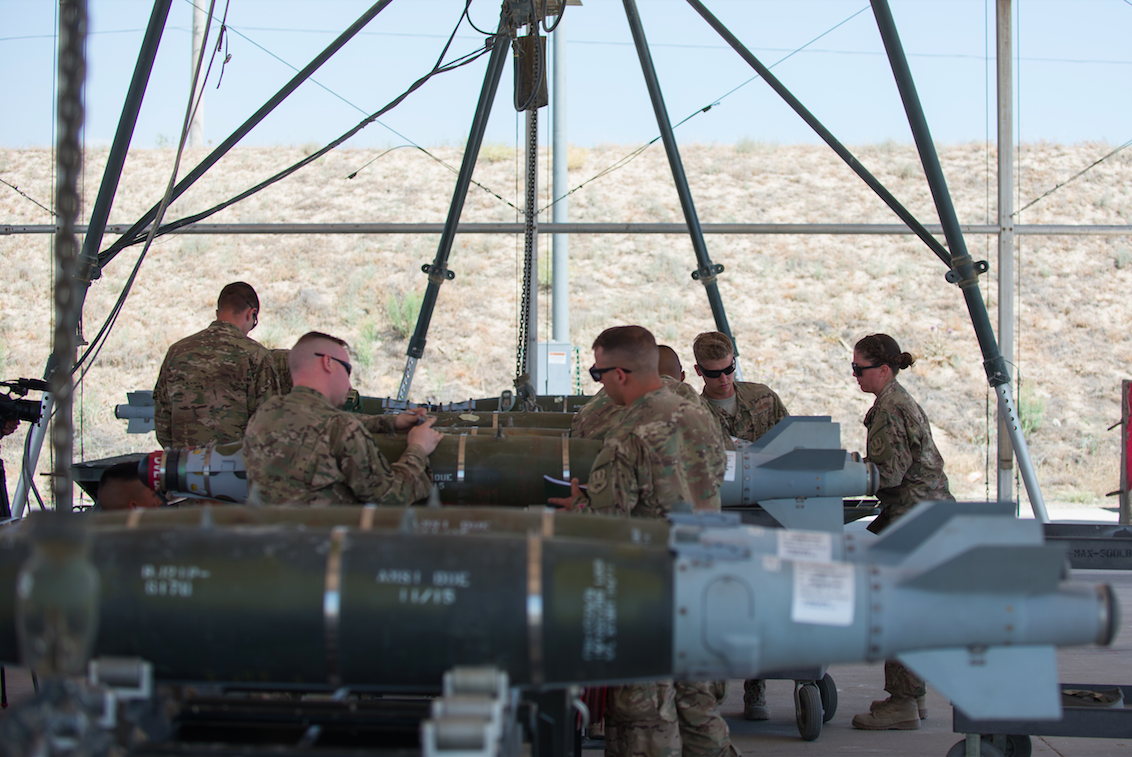
Airmen assigned to the 455th Expeditionary Maintenance Squadron Munitions Flight perform six-month inspections on Guided Bomb Unit-54 (GBU-54) munitions at Bagram Air Field, Afghanistan, June 15, 2015. Air Force photo by TSgt. Joseph Swafford.
The Air Force’s big push to replenish its depleted stocks of munitions, as well as the rate at which it will buy F-35s, are both tied to the Strategic Defense Review and other ongoing reviews, Undersecretary of the Air Force Lisa Disbrow said Friday.
In the case of munitions, however, the big increase in the Fiscal 2018 budget request is only the beginning of a sustained big push.
In an editorial board with Air Force Magazine, Disbrow said USAF’s self-described “maxing out” its suppliers to build precision-guided munitions as fast as possible in FY18 is “the beginning of several years where we have to restock and re-up.” She acknowledged USAF must rebuild weapon stockpiles heavily drawn down by the war against ISIS, but how long that will take is still to be decided, both by operational necessity as well as several special and periodic reviews.
“We’re taking a look across the munitions … that we’re expending” as well as the maximum rates at which industry says it can supply them, to see “whether our assumptions about the max rates hold,” Disbrow said. Together with industry, “we are looking at … whether … we can partner to do more.”
A periodic Pentagon review of munitions needs across all the services will also soon be underway, and the Defense Strategic Review will set a “force-sizing” construct that will further inform total inventory objectives, she said.
“So, it’s a combination of what we’re expending today, what we project over the next five-to-10 years, what conflict requirements will be, and how much you reset after a major conflict. Do we reset that inventory or not? So all that goes into the total munitions requirements.”
Asked how long USAF will have to buy weapons at max rate if no assumptions change, Disbrow said she did not know, but “I do know we’re looking into it.”
As for the surprising Air Force move to only include 46 F-35As in the FY18 budget—when USAF leaders have been pushing hard for an increase to 60 or higher—Disbrow said the number is the product of an effort to “balance” the needs of modernization with readiness and manpower.
“We would, as an Air Force, like to get to 60 a year” and “perhaps even exceed that at some point,” but 46 seems to be the limit “within the topline that we have.”
Disbrow could not comment on the Air Force’s “unfunded priorities list” released hours later, which included 14 more F-35As at a cost of $1.76 billion; stated as the service’s fourth-highest priority.
It’s not as easy as simply setting a number, Disbrow said, due to the “lead items and the supply chain” implications. Lt. Gen. Christopher Bogdan, who stepped down last month as the F-35 Joint Program Office director, told Air Force Magazine in an exit interview that one of the biggest obstacles to increasing the fighter’s production rate is the ability of parts producers to “keep up.”
Moreover, “We don’t have clarity yet on where [Capitol] Hill is headed with the Budget Control Act,” which could mandate another fiscal sequester of defense, Disbrow said. The base budget, however, “combined with what we’ll be asking for in the supplemental request” gives an indication of where USAF wants to go.
The Defense Strategic Review will also have a bearing on the F-35 buy rate, Disbrow said. “We’re working with CAPE [the pentagon’s Cost Assessment and Program Evaluation shop], and the Joint Staff, and our own numbers,” she said, but 1,763 F-35As remains “our ?projected total procurement number.” She also said the Pentagon needs “to be clear” in discussing the F-35 production because “we’ll never have all those on the ramp at one time.”